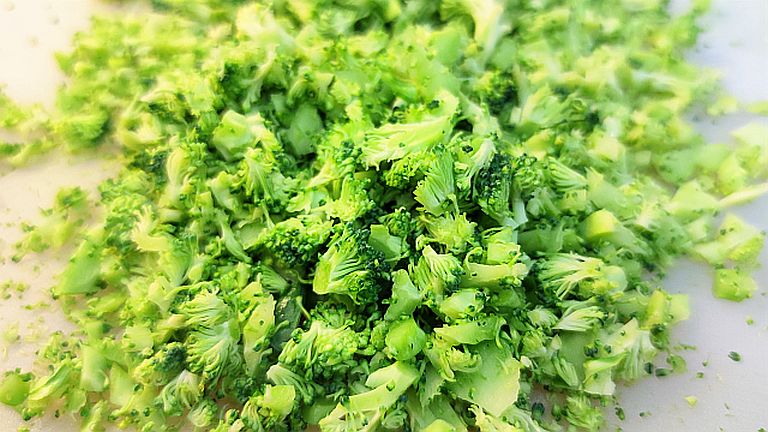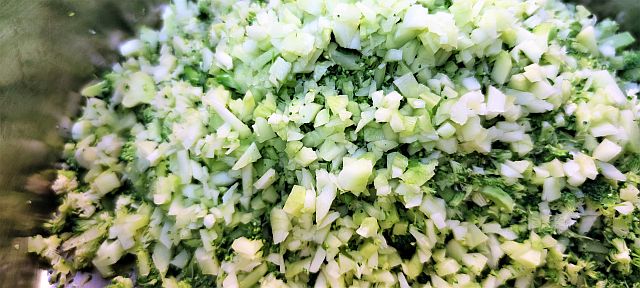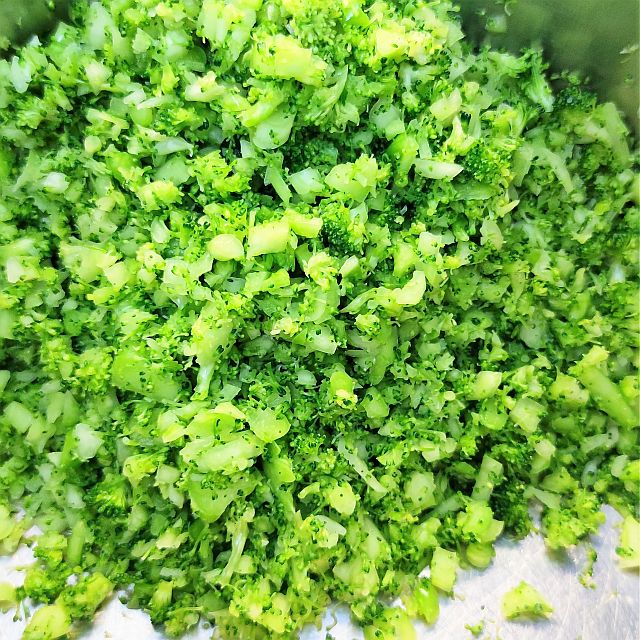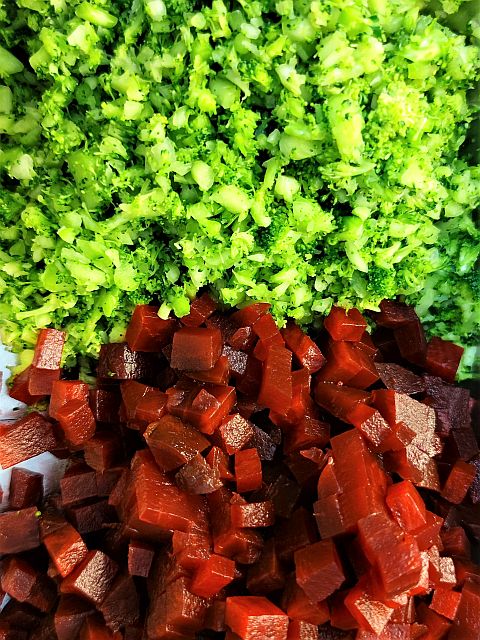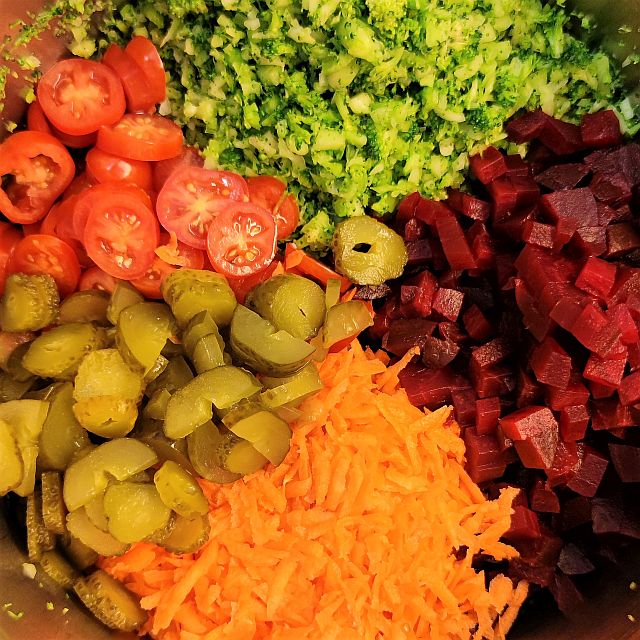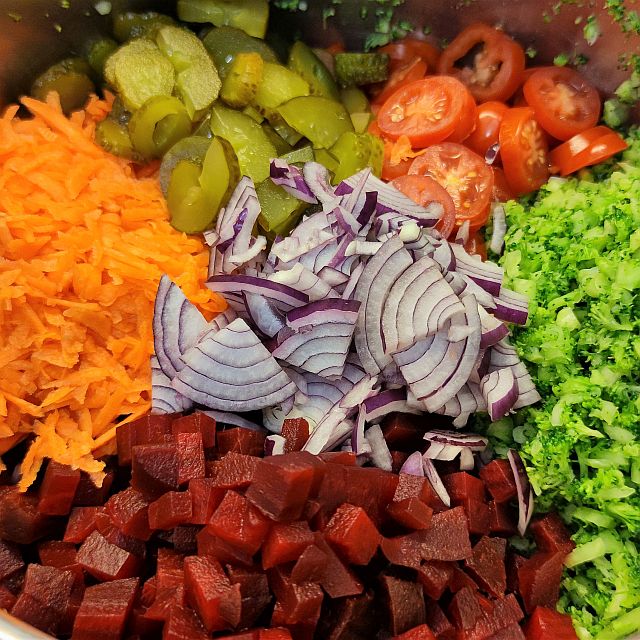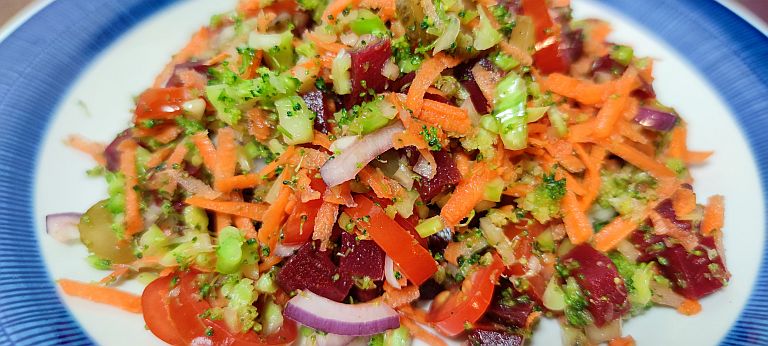It’s light and refreshing, and it keeps well in the fridge for a couple of days. It is perfect for summer and barbecues, picnics, cookouts, parties, but also lightens up a quick boring lunch break.
It is packed with superfoods with both broccoli and beetroot as a base and bursting with micronutrients, vitamins and phytochemicals. It is so healthy and nourishing and yet so delicious and scrumptious that you will happily munch on the whole bowl and come back for a second helping. It’s truly like eating a rainbow!
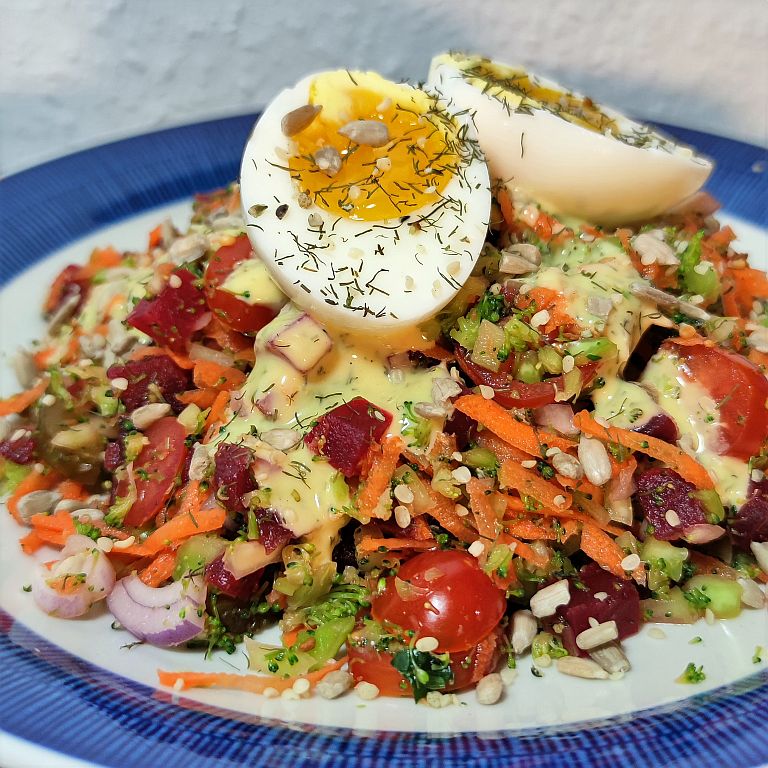
Why You’ll Love This Recipe
Cauliflower is the star of low-carb cuisine because you can use its white, bulbous inflorescences to make pretty much all kinds of high-carb dishes. When pureed, it is ideal as a substitute for all types of wheat flour-based dough – who does not know the famous cauliflower pizza crust? Chopped or grated, it can be used as a rice substitute in a variety of dishes from nasi goreng to sushi.
Its green little brother called broccoli is a little behind in second place. Sure, there are fantastic ways to oven roast it and flavor it with things like maple syrup and tahini. You can also grate it like cauliflower and process it as broccoli rice and use it in stir-fries, for example. But the attempt at fraud is even more obvious here than with cauliflower, which even at first glance passes for rice. The basic color is too green, the small green buds are too clearly visible and the cabbage aroma is too pronounced.
And too vivid are the memories of the boring, cooked-to-death broccoli we were tormented with throughout our childhood. In my opinion, broccoli took the place in the 90’s that spinach had in the 50’s and 60’s. Basically an instrument of torture for children. Boiled and mashed to an undefined dead pulp. Spices are a foreign word anyway and then the children choke on them.
With this recipe I found a new way to prepare broccoli that works perfectly for me. I see it as a challenge to hit the right doneness when preparing broccoli. Especially if you cook broccoli in boiling water, it quickly becomes too soft and mushy. On the other hand, if you cook it too short, it is so hard that it is often a little uncomfortable to eat.
However, like all other members of the Brassica genus, the cabbage vegetable, broccoli can also be eaten raw. It doesn’t contain any ingredients that would first have to be broken down by heat treatment (such as green beans, which contain the heat-sensitive toxin phasin). On the contrary, broccoli is very digestible even when raw.
In this recipe, I’ve adopted a method of preparing the broccoli that’s typically used when preparing cabbage salads: thoroughly kneading the chopped cabbage leaves by hand. The addition of salt before kneading intensifies the mechanical force on the cell walls, they become partially permeable and release the cell fluid. During the subsequent marinating process in the salt-saturated solution, the broccoli pieces can continue to soak and pickle. The result is a broccoli salad in which the individual pieces are still fresh and crunchy, but at the same time crumbly enough to create a pleasant chewing impression and are by no means too hard. The pickling also wonderfully mixes and harmonizes the different aromas. In short, an exciting new way to enjoy broccoli!
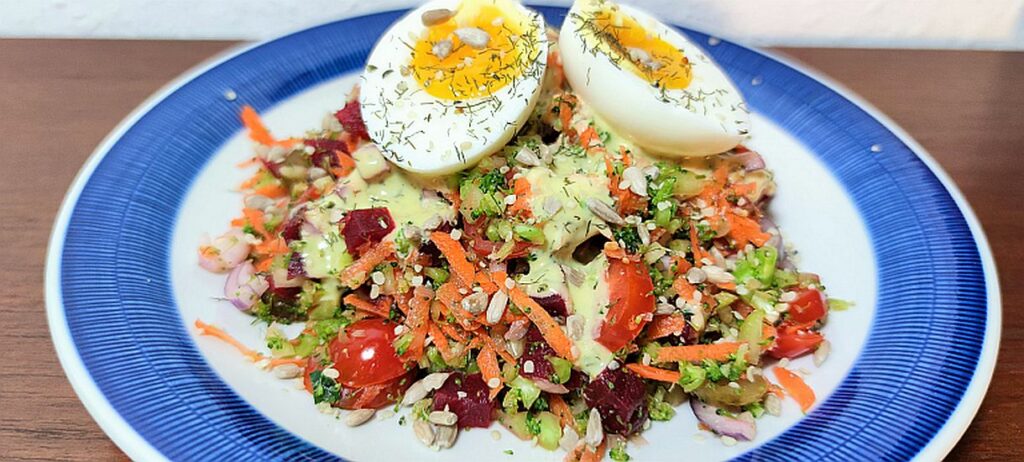
Broccoli Slaw Recipe Tips and Variations
Cut it small and mix well –
This is how the aromas of the individual ingredients can best combine and the salad is most pleasant to eat when you have combined different ingredients on each spoon. Chopping the broccoli very small allows it to marinate best in the brine and get the best bite
Take time to marinate –
the salad tastes best when it is well drained. I like to make a large amount of it so that I can eat it for several days. It tastes even better on the second day than on the first! There are no delicate lettuce leaves, all the vegetables used are robust and durable and benefit from it
Make it vegan –
with its colorful mix of vegetables, this salad suits almost all diets. If you use a vegan mayonnaise and serve it as a main meal or as an accompaniment to a vegan protein source, this is a great vegan salad
Take a shortcut –
instead of cutting and chopping all the ingredients by hand, make use of your electric food processor! It’s so much faster and easier if you let the machine chop up the broccoli, carrots, and onions! You should only cut the beets and the tomatoes and gherkins by hand.
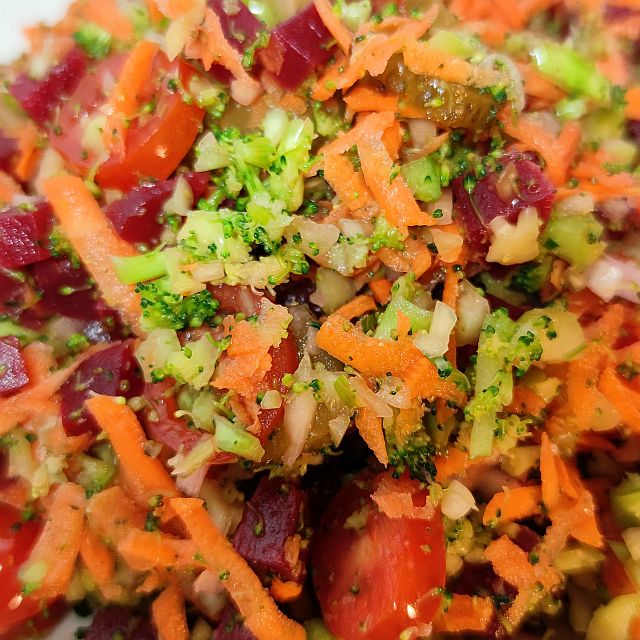
Ingredients and substitutions
Broccoli – the broccoli is irreplacable!
Since the broccoli is processed raw, it is particularly important that it is fresh and crisp. If it already has brown spots, cut them away generously. For the broccoli slaw you can use the whole broccoli head. No reason to throw away the stalk! Place the broccoli on a cutting board and use a small kitchen knife to cut the broccoli florets off the stalk. Now cut them individually into small pieces with a large chef’s knife. You can either try cutting the stalks into small cubes (Brunoise) or sticks (Julienne), or you can just roughly chop them like I did.
Now for the broccoli stalk: unlike the finer branches, the large stalk is covered in a tough, leathery skin that is not pleasant to eat and should be removed. First, cut off the bottom end of the broccoli stalk generously—it’s usually dried out and woody. Then place the stalk upright on the cutting board and use the chef’s knife to cut away the skin around the stalk. You have now exposed the soft interior of the broccoli stalk. Feel free to try it raw. What does it taste like? Fresh and crisp, it bears a striking resemblance to kohlrabi.
This is no coincidence, as it is the same botanical part of the plant that was grown to be large and thick in the kohlrabi. If you process the stalks when you cook broccoli, you are not only acting according to the zero waste principle and avoiding food waste – no, you have also gained a little culinary extra that brings an extra dimension of taste and texture to the dish. Now cut off any remaining woody parts of the peeled broccoli stalk. You can now cut the remaining soft core lengthways into thin slices and then cut or chop them into strips.
To prepare the broccoli slaw, put the broccoli snippets in a large bowl – there should be enough space for kneading – and add a generous amount of salt. It can be a bit “too much” for the broccoli. All the other salad ingredients are also seasoned with this salt, so to speak
Now knead the broccoli snippets vigorously with your hands. Here you can apply a lot of force and squeeze. The broccoli is robust enough. Keep doing this until some liquid comes out. Cover the bowl and place in the refrigerator. The broccoli can now marinate for up to a day. But you should at least give it enough time to finish preparing the other salad ingredients.
Red beetroots – the second secret star of the recipe.
Beetroots make a great addition to any salad as their al dente yet soft and smooth texture contrasts well with crisp or crunchy salad ingredients. I think beetroot and broccoli complement each other very well in terms of taste. I think there is nothing wrong with using the peeled and pre-cooked beetroot. It’s a convenience product that really makes sense, that doesn’t need any additives and saves a lot of time, especially for salads. But it shouldn’t be the sweet and sour pickled beetroot from the jar, but only the pure boiled ones.
If you have fresh or stored beets on hand, all the better. To prepare them for the salad, you need to do the following: first wash them thoroughly, then peel them (it’s best to use gloves as they stain a lot) and cook them whole. They will bleed less, i.e. lose color and valuable ingredients, and the cubes will look better in the salad afterwards. Now steam them, just covered with water and salted, for about 40 minutes or until they have a consistency that is firm to the bite. A sharp kitchen knife can then penetrate the center of the tuber without much effort. Alternatively, you can also prepare the peeled beets in the oven. Even then they need about 40 minutes to an hour. I think they get especially flavorful in the oven.
Let them cool down and then use them for the salad like the pre-cooked beetroot – trim off any existing roots and cut the rest of the tuber into small cubes with an edge length of approx. 5 mm. Instead of beetroot, you can also use yellow beets, white beets, ringlets or a mixture of different varieties. This makes for a welcome variation. However, you will usually only find these at the weekly farmers market when they are in season during summer and autumn.
Carrots – a welcome addition to any coleslaw
They bring some sweetness, crunch and their bright orange color to the dish. They also harmonize perfectly with the other root vegetables. It is best to use large carrots as they are easier to grate. It doesn’t have to be the fine and tender carrots that still have fresh greens, but can also be the large stored carrots that you would also use for soup. So it makes sense to peel them before processing. Grate them into coarse shreds on the coarse side of a kitchen grater.
If you have a julienne cutter handy, you can use that as well. Then the carrot pieces get a smooth edge and a square cross section. They just look nicer that way. In principle, you can also knead the grated carrots together with the broccoli and let them marinate, but you can also add them to the dish with the other vegetables at a later point in time.
Tomatoes
Here I use small cherry tomatoes or date tomatoes, which I cut lengthwise into slices about 1-2 mm thick so that they get a nice cross-section. Admittedly, tomatoes are not typical ingredients for a coleslaw or broccoli slaw. But they are just great for any salad. They bring a nice fruity acidity that this salad would otherwise lack. If you’re on a Paleo diet following the autoimmune protocol or need to avoid nightshade for any other reason, just omit the tomatoes.
Red onions
I prefer to use red onions in salads because they are so flavorful and mild. In addition, they look so pretty with their two-tone structure and are extra nutritious due to the anthocyanins contained in the red dyes. You can use the milder spring onions or leeks cut into fine rings if the taste of raw onions is too overpowering. Alternatively, you can also use white onions, shallots or the large, mild vegetable onions.
Brined gherkins
these little cucumbers are fermented in a salted pickle liquid or brine. They add extra flavourful, savoury little bites to the broccoli slaw. In addition, the add an fermented ingredient. If you don’t have pickled cucumbers available, you can use any kind of pickled gherkins or fresh cucumbers. But other pickled salad ingredients also serve the same purpose of raising the umami level. How about chopped olives, capers or pickled onions? If you want a little more spiciness in the dish, pickled slices of jalapeno will do the trick.
Dressing
Here I use a maple syrup mustard dill dressing that has been filled with mayonnaise. Honey Mustard Dressing is a fantastic option for an everyday salad dressing recipe as it can be made entirely with ingredients from stock. Dill makes the dressing extra flavorful. Here I mixed the dressing with equal parts mayonnaise to make it extra creamy and not too intense. By using vegan mayonnaise, the entire dish becomes vegan. If you follow a Paleo diet or Whole30 diet, you can also adapt the salad to your dietary needs by using suitable mayonnaise.
A mustard-based salad dressing goes well with the broccoli. Mustard and collard greens are closely related and both contain mustard oils with their pungent, slightly sulphurous flavor. This taste nuance is only underlined and accentuated by the combination. Alternatively, you can also prepare a creamy coleslaw dressing without mustard or use a tomato American dressing.
You either have to freshly prepare the mayonnaise yourself using a suitable oil such as olive oil or avocado oil, or use the storebrought alternatives that are now available.
How to store:
You can easily store the broccoli slaw in an airtight container in the fridge for up to 3 days. It makes an ideal option for meal prep for a lunch.
You can easily store the broccoli slaw in an airtight container in the fridge for up to 3 days. It makes an ideal option for meal prep for a lunch. But I would recommend adding the dressing just before serving. So keep the chopped veggies and the dressing in separate containers until you’re ready to serve.
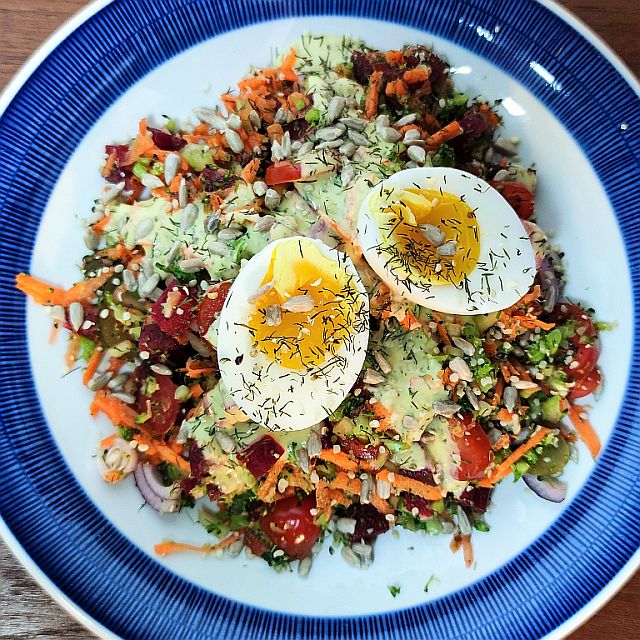
Broccoli Slaw
Description
This broccoli slaw is an outstanding variation of both normal broccoli salad and conventional coleslaw and brings a special twist to the preparation of broccoli.
Ingredients
for the dressing
for the salad
Instructions
-
Wash the broccoli and chop the florets coarsely into small pieces (<5 mm)
You can use the stem too. Cut off the hard, leathery skin all around with a sharp knife and process the inside in the same way as the rest of the broccoli florets. -
Place the broccoli snippets in a large bowl and carry on just as you would with a normal coleslaw: Salt generously and knead the pieces vigorously by hand. Use good force until the broccoli begins to seep liquid.
-
Let the broccoli sit in the fridge for some time. At least as long as you need to prepare the remaining ingredients.
-
If using pre-cooked beets, cut them into 5mm cubes.
If you have raw beetroots, look for the instruction in the ingredients section how to cook and prepare them first.
-
Wash and peel the carrots and grate them coarsely.
-
Cut the cherry tomatoes and gherkins into slices which are 2mm thick.
-
Peel the onions and cut them into thin strips.
-
Add all of the other vegetables into the bowl with the salted broccoli.
-
Combine the ingredients for the dressing, the mayonnaise, maple syrup, mustard and dill, in a small mixing bowl. Add salt and pepper and season according to taste.
-
Serving suggestions
Sprinkle with some fresh herbs, sunflower seeds and hemp nuts and accompany with either boiled eggs or any kind of grilled or cured meat.
Notes
This salad is best kept fresh, when it is mixed with the dressing directly before eating and stored without dressing. So if you are not going to use everything in one meal, store the salad ingredients in an airtight container in the fridge and mix only the portion with the dressing that you are about to use.


